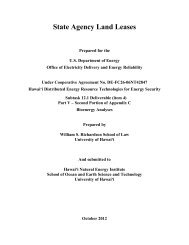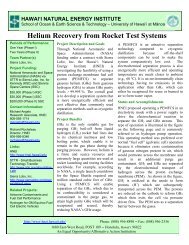Oahu Wind Integration Study - Hawaii Natural Energy Institute ...
Oahu Wind Integration Study - Hawaii Natural Energy Institute ...
Oahu Wind Integration Study - Hawaii Natural Energy Institute ...
Create successful ePaper yourself
Turn your PDF publications into a flip-book with our unique Google optimized e-Paper software.
1.6.5. Loss of cable delivering off-island wind energy causes large underfrequency<br />
events<br />
In addition to looking at the impact of wind power variability events, traditional contingency<br />
events like instantaneous loss of generation were considered. With the installation of the<br />
undersea cable system, the largest single-contingency event for loss of generation on the <strong>Oahu</strong><br />
system would be an undersea cable trip. Screening parameters included high wind plant output<br />
and low system up-reserves. For these criteria, an hour was selected in Scenario 5 when the<br />
system load was 1020 MW and the total wind power generation was at 363 MW, out of which<br />
282 MW came from off-island plants. The system up-reserve capacity was relatively low at 267<br />
MW, when a 200 MW cable trip was simulated. This was just prior to committing a unit to meet<br />
up-reserve requirements. Figure 1-14 shows the results for this event.<br />
<strong>Wind</strong> Plant<br />
<strong>Wind</strong> Plant<br />
Figure 1-14. 200 MW cable trip event in Scenario 5 with future thermal unit droop characteristics,<br />
with and without wind turbine inertial-type response. Second figure shows response from<br />
remaining off-island wind plant.<br />
The top graph shows the system frequency in the first 100 seconds after the undersea cable trip<br />
and the bottom graph shows the simulated wind plant output from the remaining off-island wind<br />
plant, after the cable trip event. The wind plant was supplying 82 MW of power at the beginning<br />
of this event. Since this is a transient event, no action of the Automatic Generation Control<br />
(AGC) is considered. The graph illustrates the results under two sets of assumptions. For the<br />
initial analysis (results shown in blue), the wind plant has no advanced capability to help the<br />
system respond to these events. Thus, power output from the wind plant remains constant<br />
throughout the event. The curve shown in red assumes the wind plant is capable of providing<br />
commercially available inertial-type response and can provide a short-term increase in power<br />
output. The second graph shows a rapid increase in power from the wind plant, by<br />
approximately 20 MW, in the first few seconds after the cable trip.<br />
With no inertial-type response from the wind plants, the system frequency drops to 58.5 Hz,<br />
triggering ~55 MW of load shedding. By implementing wind plants with inertial-type response<br />
22




